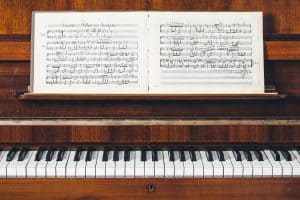Let’s take a look at ties in music notation and see how they affect the music you play. There are many different kinds of marks and symbols across the sheet music. These symbols are instructions on how the music should be played. Some are to do with rhythm while others are to do with pitch.
Some of these marks and symbols can be quite small (such as a dot!) yet have an enormous impact on how the music sounds. Sometimes a symbol is used to mean more than one instruction depending on how it’s used, and the tie is one such symbol.

What is a tie in music?
A tie is a way of increasing the length of a note in a place where writing a single note of a longer value isn’t possible. A tie is a curved line linking two notes of the same pitch, like this:

In this example, we have a tie between two quarter notes. A quarter note is worth one beat, but when a tie symbol links two quarter notes, it effectively becomes a half beat.
How to play a tie
When you see a tie, play the first piano key, but instead of playing the second one, hold the key down for the value of the second note. In the previous example you would hold the tied C for the second beat, just as if you were playing a half note.
In the following example, the tie changes the fourth quarter note into a five beat note:

In the following example, the first note is a whole note (4 beats) tied across the bar line into the second measure to another whole note. This makes the note into 8 beats total.

Tied notes within the same measure are notated to keep the structure of beats clear. In the following example, 8th notes (quavers) are tied so that a note appears on each of the strong beats. This rhythm sounds off-kilter and kind of jazzy:

Why are tied notes important?
So why not just write quarter notes instead of all those tied 8ths? Wouldn’t that be easier? The answer is because the second 8th note falls on the weaker half of the first beat. The third 8th note is the strong second beat, and should have a note to show it clearly – even though that note isn’t played, but held.
What about higher value notes?
In 4-4 time signature, you can only have 4 beats per measure. There is no single note to represent five beats. So the only way to make a 5-beat note is to join a 4 beat and a 1 beat, by using a tie. And the only way to make an 8-beat note is to tie two whole (4 beat) notes together.
What are ties used for?
Ties are used in one of two situations:
1. The second note falling on the beat
When depicted as a half note it can sometimes be hard to see when the second beat falls. A tie acts as a visual guide to the beat so that sight-readers can see where the beat falls.
2. A note held across the bar line
When a note is sustained over the bar line into the next bar, a tie must be used to indicate the extra duration.

In this case, we have a quarter note tied to a whole note across a barline. A whole note is 4 beats long so this note becomes worth five beats.
Practice playing ties
A good starting point for learning to identify ties and get used to playing them correctly is the beginner course “Get In Touch With Skoove” and play Bill Wither’s Lean On Me.

Have a listen to the song in our course and notice the duration of tied notes. While practicing the song, make sure to hold the tied notes all the way to the end of the 3rd and 5th bars. You can try adding in some basic piano chords with the melody.
Once you’ve got that, another good song to practice playing ties is “Pirates of the Caribbean”. It’s the tied notes that gives this song the “off-beat” rhythm that’s so catchy.

Music ties usually only tie between two consecutive notes, but can include more consecutive notes as long as they are the same pitch.
Here’s an example of several tied notes. Notice they are always the same pitch.

What is a slur in music?
We have to talk about slurs because the same symbol of a curved line is used to mean something else and you need to know how to tell them apart. A slur instructs you to play a sequence of notes smoothly, (rather than detaching them). This gives you a smooth melody line as you move from one note to the next without a break in the sound. The Italian term for this is “legato”. It can also be referred to as a “phrase mark”.

In this example the curved line is called a slur. Notice that the line connects two notes of different pitches while music ties connect two notes of the same pitch. Slurs can extend across multiple different notes like this:

This is the beginning of Beethoven’s “Fur Elise” one of the most popular piano songs of all time. In order to make it sound smooth and expressive, we use a slur to instruct the player to use legato technique.
Simply put, slurs affect the way you play the notes while music ties affect the rhythm.
How to decide between ties and slurs
Both a slur and a tie is a curved line. When you see a curved line between two notes, check to see if the notes are of the same pitch or different pitches. If they are the same pitch, it’s a tie. If they are different pitches, it’s a slur.
Very often a slur lasts across several notes. This can be an easy clue that it’s not a tie but a slur.
Ties and slurs at the same time
There are times you’ll see both ties and slurs in the same song. Here is the opening of Nocturne in Eb major by Chopin:

This is more advanced music notation using both ties and slurs. You can see that it can be confusing at first to see two different curved lines which give two different instructions.
But once you notice that the E flat is tied to the same note in the next measure, you know it’s a tie. The large curved line stretches across multiple notes, so you know that it’s a slur, meaning the notes should be played without interruption.
Get good at recognizing the difference between a tie and slur by reading lots of different songs. Use the best apps for learning piano to improve your skills.
Author of this blog post:

Georgina St George has been playing piano most of her life. She has a thriving piano school on the south coast of England. She loves to infuse her students with her passion for music, composing and performing. Her music has been featured on over 100 TV shows and her musicals have been performed in New York and London’s West End.














